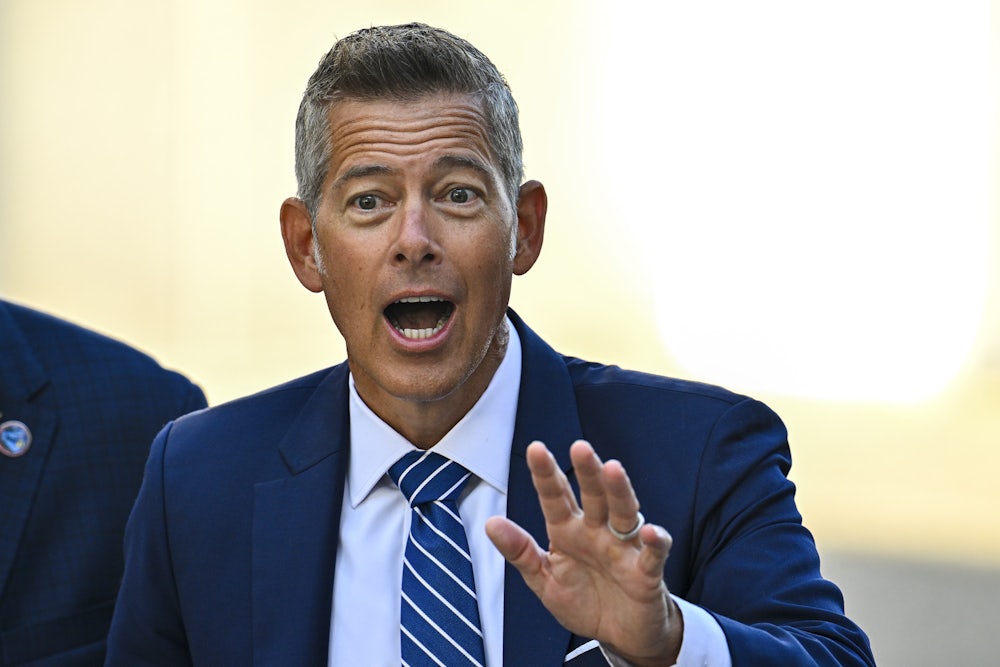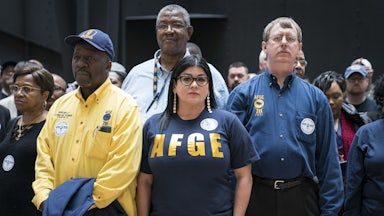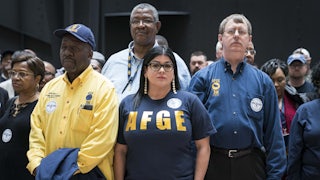Let’s discuss a problem the Abundance movement is ill suited to address: the Trump administration’s elimination of programs that reduce burdens to low-income minority neighborhoods when the government builds highways and bridges.
Abundance-ism started out last fall as three treatises against the Not in My Back Yard, or NIMBY, liberal mindset. The books (which I reviewed here and here) were Ezra Klein and Derek Thompson’s bestselling Abundance, Yoni Appelbaum’s Stuck, and Mark Dunkelman’s Why Nothing Works. These took a small reformist point (local zoning can be abused by the wealthy to shore up privilege) and enlarged it into a supply-side liberal ideology that proved irresistible to conservatives. The newly libertarian Washington Post editorial page, for instance, weighed in that “progress, not redistribution, is the main determinant of living standards,” a conclusion that I doubt the authors of these books would endorse—but that, by setting aside questions of distribution, they didn’t exactly discourage.
In the blink of an eye, Abundance-ism became an industry. Tickets quickly sold out for Abundance 2025, a September 4–5 conference in Washington, D.C., that will feature, alongside the three books’ authors, David Brooks; Republican Representative Brett Guthrie of Kentucky; Republican Governor Spencer Cox of Utah; and Dean Ball, who until recently was a senior policy adviser on artificial intelligence in the Trump White House. There’s also a new “mission-driven” Abundance-ist online magazine called The Argument featuring columns by Thompson, Matthew Yglesias, and Matt Bruenig (who gave Abundance an only mildly contemptuous review and will presumably play the role of sparring partner).
The inadequacy of the Abundance-ist outlook became clearer to me after I read another book published this fall that received much less attention: Dividing Lines: How Transportation Infrastructure Reinforces Racial Inequality, by Deborah N. Archer, president of the American Civil Liberties Union. (I interviewed Archer in April for the Washington, D.C., bookstore Politics & Prose.) Archer’s book explains that the 1956 Interstate Highway Act, which was enacted one month after the Supreme Court handed down Brown v. Board of Education, proved a godsend for conservative Deep South politicians then frantic to find new ways to preserve racial segregation.
Construction of interstate highways, segregationists realized, could be used to obliterate or isolate Black neighborhoods, and Southern state and local governments proceeded to do so with little interference from Washington. Archer further documents that local planning regarding surface roads, sidewalks, and allowable bus routes were used for the same purpose, often in recent memory. Georgia Representative Newt Gingrich, for instance, sided with white residents in Georgia’s Cobb County who opposed Atlanta city buses stopping in their suburban neighborhood. “People in Cobb County don’t object to upper-middle-class neighbors who keep their lawn and move to avoid crime,” Gingrich said. He continued:
What people worry about is the bus line gradually destroying one apartment complex after another, bringing people out from public housing who have no middle-class values and whose kids as they become teenagers often are centers of robbery and where the schools collapse because the parents who live in the apartment complexes don’t care that the kids don’t do well in school.
That was in 1994. The following year, Gingrich was elected speaker of the House.
Archer neither condemns local zoning nor praises it, noting that it can be used either to help minority communities or to hurt them. The problem at hand isn’t some context-free tool called zoning; it’s the context-rich problem called racial discrimination, which can express itself in all sorts of ways to watch out for.
Don’t get me wrong. The Interstate Highway Act was in most respects a great advance, connecting different parts of the country, increasing commerce, and eliminating many safety hazards. But as we approach its 70th birthday, the United States has an opportunity to repair and rethink many now-decaying highways and bridges that the act built in a way that helps rather than hurts low-income minority communities.
To that end, the Biden administration and Congress imposed necessary and valuable restrictions on federal infrastructure spending. The 2021 infrastructure bill included something called the Reconnecting Communities pilot program to mitigate the isolating effects of previous bad transportation decisions; its grant-making gives priority to “economically disadvantaged” communities. Similarly, the 2022 Inflation Reduction Act included a Neighborhood Access and Equity program to make transportation more safe, walkable, and affordable; its grant-making is targeted to “economically disadvantaged” or “underserved” communities. In neither case is the purpose to impose pettifogging regulations that slow the building process. Rather, it’s to send money where it’s most needed.
It won’t surprise you to learn that the Trump administration and congressional Republicans consider these programs so much woke nonsense. “The roads are racist,” Senator Ted Cruz sneered about the Reconnecting Communities pilot, shortly before it was enacted. “We must get rid of roads.”
In March, Transportation Secretary Sean Duffy rescinded two memos by his predecessor, Pete Buttigieg, that said the department favored infrastructure spending “reconnecting communities and reflecting the inclusion of disadvantaged and under-represented groups in the planning, project selection, and design process.” Duffy said the memos “flouted Congress in an attempt to push a radical social and environmental agenda.” He also slammed the brakes on the Reconnecting Communities pilot program. According to the nonprofit Transportation for America, as of July 9 the Trump administration had spent none of the $100 million allocated this year for the program, and in July the House Appropriations Committee proposed zeroing it out.
The $3 billion Neighborhood Equity and Access program, meanwhile, is dead; the “big, beautiful bill” canceled $2.2 billion that hadn’t yet been spent, according to Politico’s Chris Marquette and Sam Ogozalek, who posted an excellent story last week about the resultant pain in Republican congressional districts:
In Bowling Green, Kentucky, the law canceled 93 percent of an $11 million grant meant to boost pedestrian safety on a roadway. In western Montana, it wiped out money aimed at improving a highway on the Flathead Indian Reservation and better connecting Missoula-area communities. And on Maryland’s Eastern Shore, the law ended more than $4 million in funding that would have gone toward addressing similar concerns in two municipalities.
These communities are represented in Congress by Republicans Brent Guthrie, Ryan Zinke, and Andy Harris. The first two declined Politico’s request for comment. Harris replied with a written statement that he’s “consistently demonstrated his commitment to providing appropriate constituent assistance while upholding fiscal responsibility.” Tell that to Zack Tyndall, mayor of Berlin, Maryland. Tyndall told Politico that he couldn’t get Harris’s office to call him back about the matter until its reporters asked a Harris spokesman to comment. The district director who finally called him, Tyndall told Politico, didn’t appear to know much about it. (Governing magazine’s Jared Brey also had a good article in July about Congress killing the Neighborhood Equity and Access grants.)
The programs that Trump is shutting down demonstrate the inadequacy of the Abundance narrative that Building Is Good. Building is often good, but it can sometimes be bad, and when it’s bad it might take more building to fix whatever problem it creates. Take Philadelphia’s Chinatown Stitch. In the 1970s, the city rammed an expressway through its 100-year-old Chinatown, nearly killing it off. In recent years, the city decided to reunite the neighborhood’s two halves by capping the expressway with a public park in a manner similar to the “Big Dig” rerouting of Boston’s Central Artery in the 1990s (though on a much smaller scale). To build the Chinatown Stitch, Philadelphia in 2024 secured a $158 million grant, but in July the “big, beautiful bill” clawed back 95 percent of the funding, leaving the project’s future in doubt.
The Chinatown Stitch, if it gets built, will show how new construction can shore up a minority community. But when the Philadelphia 76ers last year contemplated building a basketball arena that threatened to cut Chinatown off from the rest of the city, the neighborhood fought it and won. To the inhabitants of Philadelphia’s Chinatown, development is neither good nor bad; the question, rather, is how to direct development in ways that benefit the people who live there—or at least doesn’t screw them over. Answers to such questions don’t adhere to simpleminded formulas like NIMBY or YIMBY. The sensible approach is SIMBY—sometimes in my backyard. Circumstances matter, interests differ, and these need to be taken into account, preferably in an expedient manner. But nobody’s going to throw a conference to say that.










